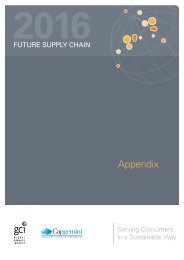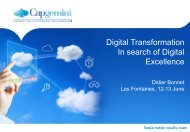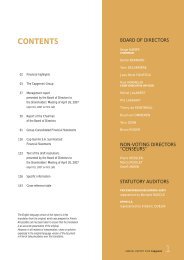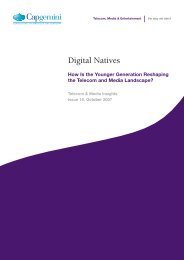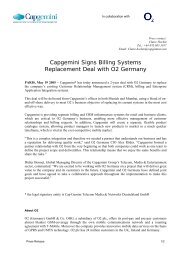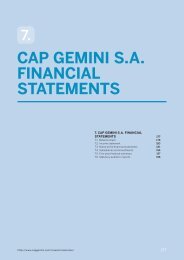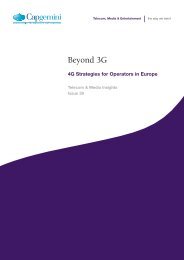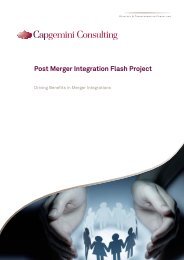Transportation Management Report 2011 - Capgemini
Transportation Management Report 2011 - Capgemini
Transportation Management Report 2011 - Capgemini
You also want an ePaper? Increase the reach of your titles
YUMPU automatically turns print PDFs into web optimized ePapers that Google loves.
Figure 21: Most important product development (mentioned at least two times)<br />
Product development Number of times mentioned<br />
Supply Chain integration 15<br />
Software as a (web)service 14<br />
Service Oriented Architecture (SOA) 14<br />
Mobile solutions and board computers 13<br />
Integration with ERP/CRM/WMS/APS software packages 8<br />
Custom made integration with other packages 5<br />
Regulatory and environmental aspects and concern 4<br />
Carbon Footprint calculations 4<br />
RFID / Tracking and tracing 3<br />
Figure 22: Technical run options<br />
Technical run option Number of times mentioned<br />
Dedicated 22<br />
SaaS 11<br />
Both 23<br />
When supplying solutions this can be<br />
done by:<br />
• Extending ERP systems (e.g.<br />
Oracle, SAP) with transportation<br />
modules<br />
• Integrating existing systems with<br />
ERP<br />
• Offering standard interfaces to ERP:<br />
multiple vendors offer standard<br />
interfaces to ERP systems<br />
•Using SOA in developing<br />
transportation software<br />
•Integrating TMS with WMS<br />
•Integrating different transportrelated<br />
components like planning,<br />
execution management and global<br />
trade compliance<br />
45<br />
Collaboration in the industry will<br />
increase<br />
Collaboration within industries will<br />
increase over the next few years<br />
as companies seek ways to not<br />
only lower costs but also reduce<br />
CO2 emissions. A good example is<br />
collaborative warehouses situated<br />
outside big cities that collect<br />
shipments for those retailers using<br />
the site and then combine those<br />
shipments to create full truck loads.<br />
This type of arrangement requires<br />
manufacturers and 3PLs/4PLs to have<br />
a software integration that allows<br />
complete and visible information<br />
exchange with the warehouse systems.<br />
Software as a Service<br />
Software as a Service (SaaS) is a<br />
growing trend in the IT world.<br />
Maybe less known but also important<br />
is Integration as a Service (IaaS).<br />
These two developments are<br />
particularly relevant in the TMS<br />
market. Both concepts are based<br />
on leveraging Internet technologies<br />
where companies use a pay-forservices-delivered<br />
approach. It is an<br />
alternative to on-premises solutions.<br />
What makes it particularly relevant<br />
for the TMS market is that TMS is by<br />
nature a solution that is based on a<br />
multi-enterprise business process of<br />
collaboration between shippers and<br />
carriers. In the TMS space, there are<br />
many examples of potential value<br />
from these multi-tenant network<br />
solutions, including:<br />
Trade compliance information for<br />
cross-border trade transactions.<br />
Countries around the world are<br />
constantly changing their rules and<br />
regulations. The changes can be<br />
shared and updated very efficiently<br />
using SaaS solutions<br />
Connectivity and visibility. SaaS<br />
and IaaS can offer the advantage<br />
of a large set of pre-onboarded<br />
carriers, which minimizes the costs<br />
for shippers and LSPs to connect to<br />
them. Other parties that most users<br />
need to connect to are customs,<br />
inland security and international<br />
statistics agencies. Offering standard<br />
connectivity to these organizations<br />
can provide major efficiency gains.<br />
Recognized IaaS providers include<br />
companies like GXS, Crossgate (in<br />
which SAP has shares), and E2Open<br />
(which has a partnership with Oracle





